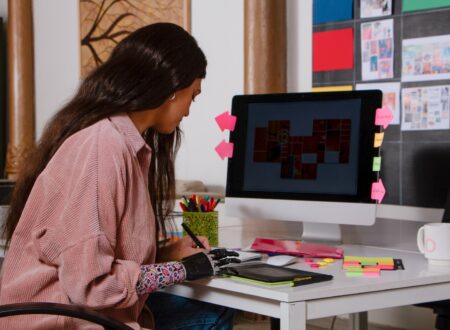Color isn’t just about aesthetics—it’s one of the most powerful tools in a designer’s toolkit. Whether you’re crafting a website, designing a logo, or decorating a room, the colors you choose can influence how people feel, think, and behave. That’s where color psychology comes in.
Color psychology is the study of how colors affect human emotions and decision-making. Different hues can evoke different feelings, and in the world of design, understanding these emotional triggers is essential to creating an experience that connects with your audience.
In this blog, we’ll explore how color psychology works, break down the emotional impact of common colors, and offer practical tips for using color strategically in your designs.
Why Color Psychology Matters in Design
Have you ever felt calm in a spa with pale blues and greens? Or felt energized by a bold red sale banner? That’s color psychology at work.
Colors can:
- Trigger emotional responses
- Influence perception of a brand or product
- Guide user behavior (like clicking a button or reading a headline)
- Establish mood, tone, and personality
In fact, studies show that up to 90% of snap judgments made about products can be based on color alone. That’s why choosing the right color palette is not just a visual decision—it’s a psychological one.
Emotional Associations of Common Colors
Let’s look at the emotions and meanings typically associated with different colors. Keep in mind that cultural and personal context can affect interpretation, but these are some widely accepted associations:
Red – Energy, Passion, Urgency
Red grabs attention and evokes strong emotions. It can signify excitement, power, love, or danger. In marketing, red is often used to create urgency (like clearance sales) or stimulate appetite (fast food chains love it).
Best for: Call-to-action buttons, food brands, sports, fashion.
Blue – Trust, Calm, Reliability
Blue is one of the most universally liked colors. It evokes a sense of calm, security, and professionalism. That’s why many banks, tech companies, and healthcare providers use blue—it signals trust and stability.
Best for: Corporate brands, financial services, healthcare, tech.
Yellow – Optimism, Warmth, Attention
Yellow is cheerful, energetic, and grabs attention without the intensity of red. However, too much yellow can cause anxiety or strain the eyes, so it’s best used as an accent color.
Best for: Youthful brands, creative services, children’s products.
Green – Growth, Nature, Balance
Green is associated with nature, health, and wealth. It’s soothing to the eyes and represents growth, making it a popular choice for eco-friendly, wellness, and finance brands.
Best for: Environmental products, health and wellness, finance.
Purple – Luxury, Creativity, Wisdom
Purple combines the stability of blue and the energy of red. It has long been associated with royalty, spirituality, and imagination. It’s a popular choice for brands that want to feel upscale or artistic.
Best for: Beauty products, luxury goods, creative industries.
Orange – Enthusiasm, Fun, Friendliness
Orange is playful and energetic. It’s less aggressive than red but still attention-grabbing. It can make a brand feel more friendly and approachable.
Best for: Entertainment, sports, food and beverage, startups.
Black – Sophistication, Power, Elegance
Black is bold, elegant, and authoritative. It conveys professionalism and luxury but can also feel heavy or intimidating if overused.
Best for: Luxury brands, fashion, tech, editorial design.
White – Purity, Simplicity, Cleanliness
White is often used to evoke minimalism, cleanliness, and space. It’s a great background color and helps other colors stand out.
Best for: Healthcare, lifestyle, tech, minimalist brands.
How to Use Color Psychology in Design
Knowing what colors mean is only half the equation. The real magic happens when you use color psychology strategically in your designs. Here are some practical tips:
1. Start with Emotion
Ask yourself: What do I want users to feel when they see this design? Calm? Excited? Inspired? Let the desired emotion guide your palette.
2. Use Color to Reinforce Your Brand Personality
A luxury brand might use deep purples or blacks, while a playful children’s brand may lean on bright yellows and oranges. Make sure your colors align with your tone and mission.
3. Limit Your Palette
Too many colors can confuse users. Stick to 2–4 core colors and use shades and tints for variation. This creates cohesion and strengthens brand recognition.
4. Leverage Contrast for Hierarchy
Use contrasting colors to highlight calls-to-action (CTAs), headlines, or important sections. For example, a bold red button on a white background is hard to miss.
5. Consider Cultural Context
Colors carry different meanings across cultures. Red may symbolize luck in China but danger in Western contexts. Always research your audience if you’re designing for global users.
Examples of Color Psychology in Action
- Coca-Cola: Red conveys energy, passion, and excitement—perfect for a brand that wants to evoke emotion and enthusiasm.
- Facebook: Blue suggests trust, connection, and calm—ideal for a platform that’s all about relationships and reliability.
- Whole Foods: Green reflects health, nature, and organic living—exactly what the grocery brand wants to represent.
Final Thoughts: Design with Intention
Color is more than decoration—it’s communication. Every hue you choose sends a message, consciously or not. By understanding the psychology of color and applying it with intention, you can design experiences that resonate, convert, and inspire.
Whether you’re building a brand, launching a product, or refreshing your website, always ask: What does this color say? If it speaks the right emotional language, you’re one step closer to creating a design that truly connects.





